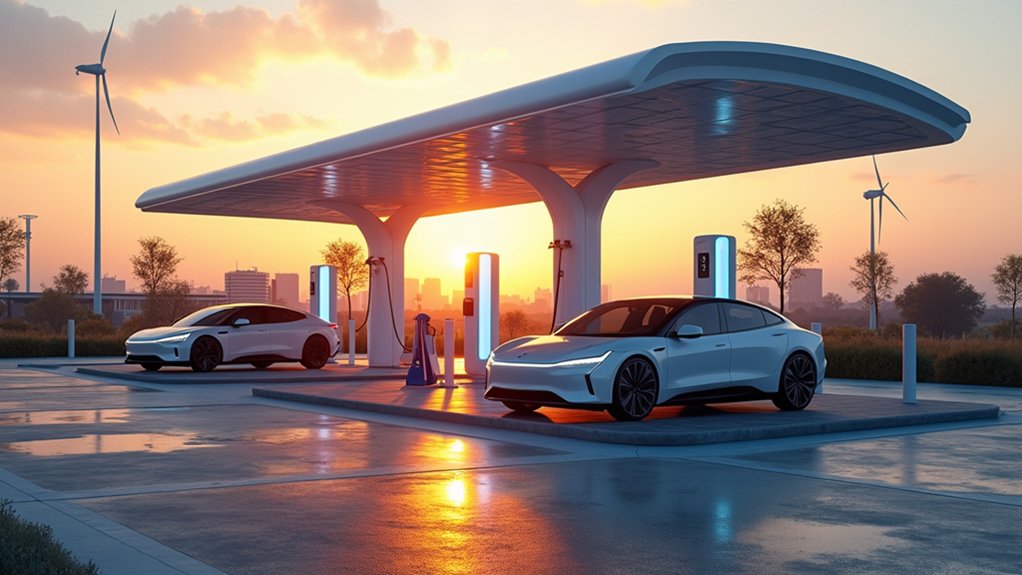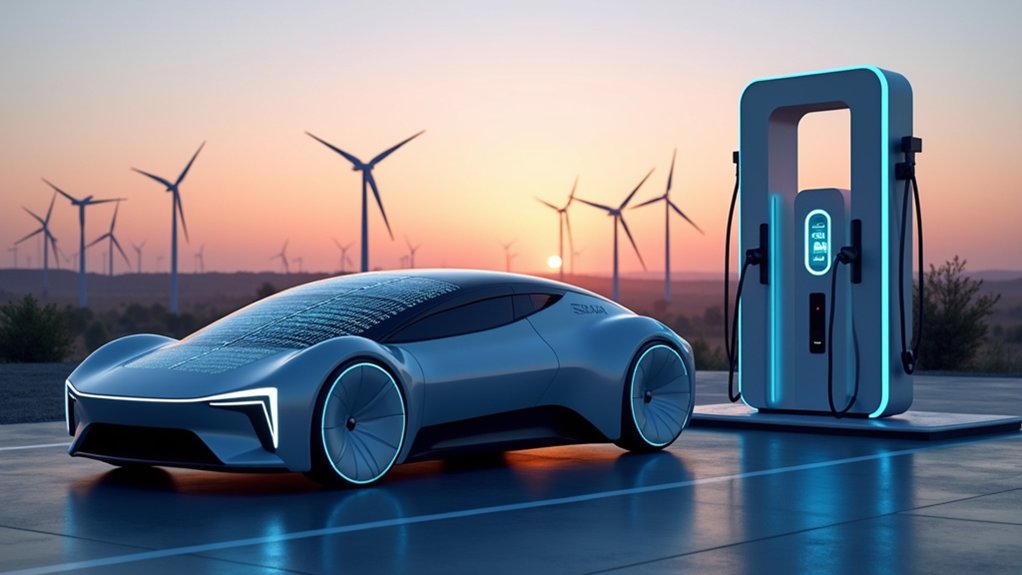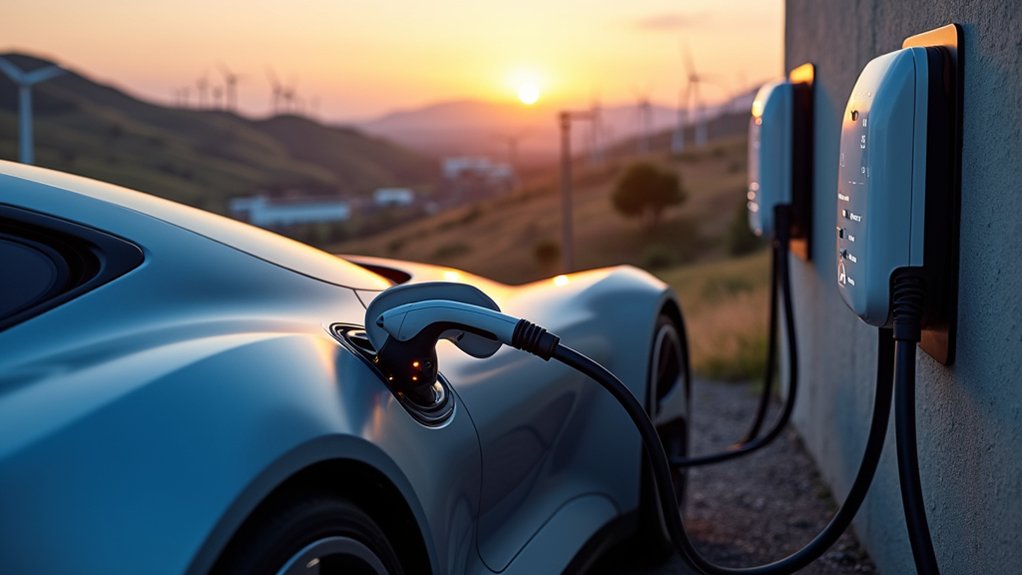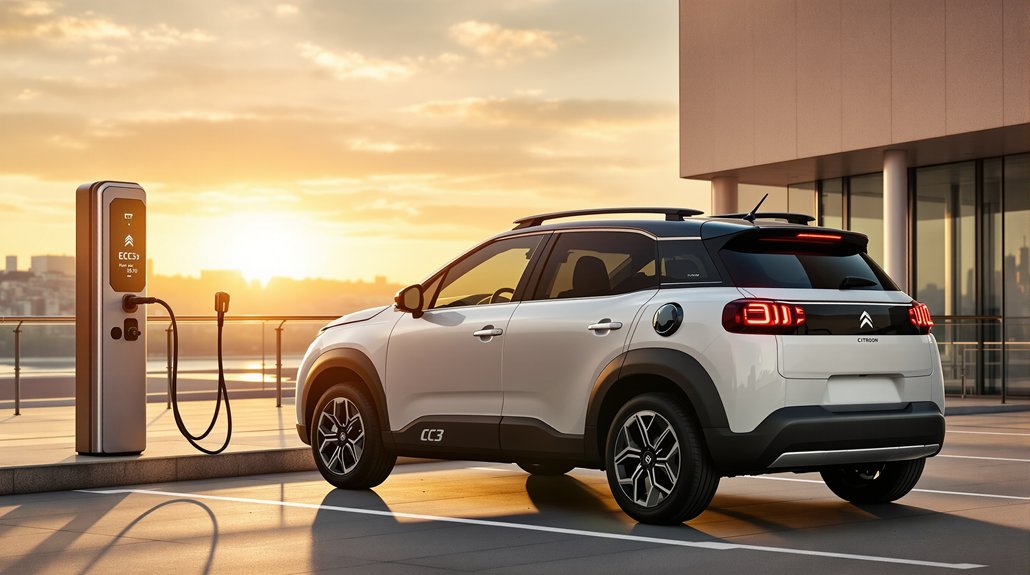The future of EV charging stations promises transformative advancements in technology and accessibility. The U.S. government’s commitment to 500,000 public stations by 2030 coincides with innovations in ultra-fast charging, wireless solutions, and AI-driven smart grid integration. Bidirectional charging capabilities and renewable energy sources are reshaping station operations, while mobile apps streamline the user experience with real-time updates and contactless payments. These developments mark the beginning of a thorough evolution in sustainable transportation infrastructure.

The electrification revolution sweeping across the automotive landscape has made EV charging infrastructure a critical cornerstone of sustainable transportation. Government initiatives are driving unprecedented growth, with the United States committed to installing 500,000 public charging stations by 2030, while global charging points increased by 37% in 2021 to reach 1.8 million installations worldwide. Strategic location planning focuses on high-traffic corridors to ensure maximum accessibility for drivers across diverse regions.
The future of charging technology is rapidly evolving beyond basic power delivery. Ultra-fast chargers are dramatically reducing wait times, while artificial intelligence integration optimizes charging performance and predictive maintenance. Wireless charging solutions are emerging to eliminate the need for physical connections, and bidirectional charging capabilities are enabling vehicles to contribute power back to the grid during peak demand periods. Smart grid technology helps optimize the charging process using real-time data to enhance efficiency. With a renewed focus on technological advancement, manufacturers like Toyota are developing innovative solid-state battery systems that promise unprecedented range capabilities.
Next-generation EV charging transcends simple power delivery, incorporating AI optimization, wireless solutions, and grid-supporting bidirectional capabilities.
Environmental sustainability stands at the forefront of charging infrastructure development. Station operators are increasingly incorporating on-site renewable energy sources, while repurposed EV batteries find new life as energy storage solutions at charging locations. This integration of clean energy with smart storage systems not only reduces operational costs but also minimizes the carbon footprint of charging networks.
User experience is undergoing significant enhancement through technological innovation. Mobile applications now provide real-time updates on station availability and charging speeds, while simplified payment systems offer contactless and subscription-based options. These improvements, combined with increased station reliability, are building driver confidence in long-distance electric travel.
The transformation extends beyond personal vehicles to reshape urban mobility. Smart cities are incorporating charging hubs that serve both individual consumers and commercial fleets, while public transportation systems are developing dedicated charging infrastructure for electric buses and municipal vehicles.
This convergence of public and private charging needs is creating dynamic energy centers that optimize power distribution through AI-driven systems. The economic and environmental benefits are becoming increasingly apparent, as renewable energy integration reduces operating costs and second-life battery applications offset significant carbon emissions.
These advancements signal a future where charging infrastructure becomes as ubiquitous and reliable as traditional fueling stations, while supporting a more sustainable transportation ecosystem.
Frequently Asked Questions
How Long Do EV Charging Stations Typically Last Before Needing Replacement or Upgrades?
EV charging stations demonstrate varying lifespans based on their level classification.
Level 1 chargers typically last 3-5 years, Level 2 units endure 8-10 years, and DC fast chargers operate effectively for 10+ years.
Environmental factors, usage patterns, and maintenance quality greatly impact longevity.
Regular inspections, firmware updates, and prompt repairs can extend operational life, while technological advancements often drive upgrades before physical end-of-life occurs.
Can Extreme Weather Conditions Affect the Performance of Charging Stations?
Extreme weather greatly impacts charging station performance through multiple pathways.
High temperatures can cause system overheating and reduced charging efficiency, while subfreezing conditions slow battery chemical reactions and degrade cables.
Severe storms and flooding may physically damage infrastructure, rendering stations inoperative.
Power grid strain during heatwaves can disrupt charging availability, and snow accumulation often impedes station access and functionality.
What Security Measures Protect Charging Stations From Vandalism and Theft?
EV charging stations employ multiple layers of security protection.
Physical deterrents include tamper-proof hardware, reinforced enclosures, and strategic placement in well-lit areas.
Advanced surveillance systems utilize AI-powered cameras and motion sensors for 24/7 monitoring.
Access control measures incorporate user authentication protocols and license plate recognition technology.
Regular maintenance checks and rapid response teams guarantee equipment integrity, while public awareness campaigns encourage community vigilance against vandalism.
How Do Charging Stations Handle Power Outages and Grid Failures?
Charging stations employ multiple backup power solutions to maintain operations during outages.
Solar panels paired with battery storage systems provide off-grid charging capability, while fuel cells guarantee extended operation without sunlight dependency.
Critical facilities utilize redundant power sources and microgrids, supported by smart load management systems.
Emergency generators running on diesel or natural gas serve as final fallbacks, while AI-driven predictive maintenance helps prevent system failures.
Are There Plans to Standardize Payment Systems Across Different Charging Networks?
Significant standardization efforts are underway globally to unify EV charging payment systems.
The EU’s Alternative Fuels Infrastructure Regulation mandates card-based payments for DC chargers by 2030, while industry players are implementing universal RFID cards and mobile wallet solutions.
Consumer data shows 65% prefer standardized card payments over apps.
Current challenges include upgrading legacy terminals and coordinating between competing networks to achieve true interoperability.










1 comment